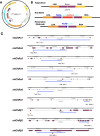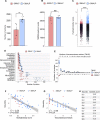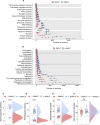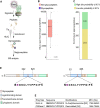Drosophila nicotinic acetylcholine receptor subunits and their native interactions with insecticidal peptide toxins
- PMID: 35575460
- PMCID: PMC9110030
- DOI: 10.7554/eLife.74322
Drosophila nicotinic acetylcholine receptor subunits and their native interactions with insecticidal peptide toxins
Abstract
Drosophila nicotinic acetylcholine receptors (nAChRs) are ligand-gated ion channels that represent a target for insecticides. Peptide neurotoxins are known to block nAChRs by binding to their target subunits, however, a better understanding of this mechanism is needed for effective insecticide design. To facilitate the analysis of nAChRs we used a CRISPR/Cas9 strategy to generate null alleles for all ten nAChR subunit genes in a common genetic background. We studied interactions of nAChR subunits with peptide neurotoxins by larval injections and styrene maleic acid lipid particles (SMALPs) pull-down assays. For the null alleles, we determined the effects of α-Bungarotoxin (α-Btx) and ω-Hexatoxin-Hv1a (Hv1a) administration, identifying potential receptor subunits implicated in the binding of these toxins. We employed pull-down assays to confirm α-Btx interactions with the Drosophila α5 (Dα5), Dα6, Dα7 subunits. Finally, we report the localisation of fluorescent tagged endogenous Dα6 during Drosophila CNS development. Taken together, this study elucidates native Drosophila nAChR subunit interactions with insecticidal peptide toxins and provides a resource for the in vivo analysis of insect nAChRs.
Keywords: D. melanogaster; Drosophila; Drosophila nAChRs; insecticidal toxins; neuroscience; neurotoxin interactions.
© 2022, Korona et al.
Conflict of interest statement
DK, CG, RQ, RP, KM, DM, MD, GJ, FE, SR, KL No competing interests declared, BD, LF is affiliated with Syngenta. The author has no other competing interests to declare
Figures















Similar articles
-
The Drosophila nicotinic acetylcholine receptor subunits Dα5 and Dα7 form functional homomeric and heteromeric ion channels.BMC Neurosci. 2012 Jun 22;13:73. doi: 10.1186/1471-2202-13-73. BMC Neurosci. 2012. PMID: 22727315 Free PMC article.
-
Molecular characterization of Dalpha6 and Dalpha7 nicotinic acetylcholine receptor subunits from Drosophila: formation of a high-affinity alpha-bungarotoxin binding site revealed by expression of subunit chimeras.J Neurochem. 2004 Jul;90(2):479-89. doi: 10.1111/j.1471-4159.2004.02499.x. J Neurochem. 2004. PMID: 15228604
-
In vivo functional analysis of the Drosophila melanogaster nicotinic acetylcholine receptor Dα6 using the insecticide spinosad.Insect Biochem Mol Biol. 2015 Sep;64:116-27. doi: 10.1016/j.ibmb.2015.01.018. Epub 2015 Mar 4. Insect Biochem Mol Biol. 2015. PMID: 25747007
-
Modes of Action, Resistance and Toxicity of Insecticides Targeting Nicotinic Acetylcholine Receptors.Curr Med Chem. 2017;24(27):2925-2934. doi: 10.2174/0929867324666170206142019. Curr Med Chem. 2017. PMID: 28176635 Review.
-
Edit, cut and paste in the nicotinic acetylcholine receptor gene family of Drosophila melanogaster.Bioessays. 2005 Apr;27(4):366-76. doi: 10.1002/bies.20207. Bioessays. 2005. PMID: 15770687 Review.
Cited by
-
Gcm counteracts Toll-induced inflammation and impacts hemocyte number through cholinergic signaling.Front Immunol. 2023 Nov 15;14:1293766. doi: 10.3389/fimmu.2023.1293766. eCollection 2023. Front Immunol. 2023. PMID: 38035083 Free PMC article.
-
Enrichment of Membrane Proteins for Downstream Analysis Using Styrene Maleic Acid Lipid Particles (SMALPs) Extraction.Bio Protoc. 2023 Aug 5;13(15):e4728. doi: 10.21769/BioProtoc.4728. eCollection 2023 Aug 5. Bio Protoc. 2023. PMID: 37575399 Free PMC article.
-
Molecular organization of central cholinergic synapses.Proc Natl Acad Sci U S A. 2025 Apr 29;122(17):e2422173122. doi: 10.1073/pnas.2422173122. Epub 2025 Apr 24. Proc Natl Acad Sci U S A. 2025. PMID: 40273107 Free PMC article.
-
Alcohol induces long-lasting sleep deficits in Drosophila via subsets of cholinergic neurons.Curr Biol. 2025 Mar 10;35(5):1033-1046.e3. doi: 10.1016/j.cub.2025.01.026. Epub 2025 Feb 6. Curr Biol. 2025. PMID: 39919743
-
A tailed mirtron promotes longevity in Drosophila.Nucleic Acids Res. 2024 Feb 9;52(3):1080-1089. doi: 10.1093/nar/gkad1158. Nucleic Acids Res. 2024. PMID: 38048325 Free PMC article.
References
Publication types
MeSH terms
Substances
LinkOut - more resources
Full Text Sources
Other Literature Sources
Molecular Biology Databases

